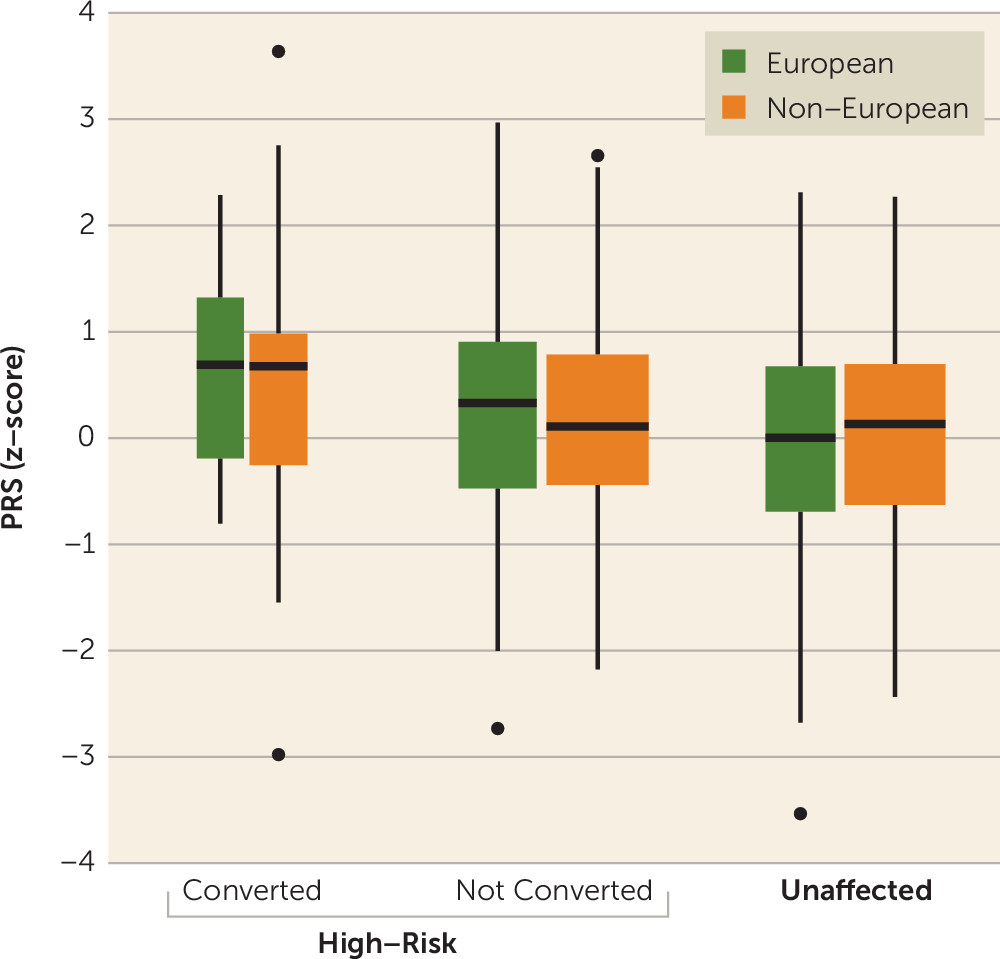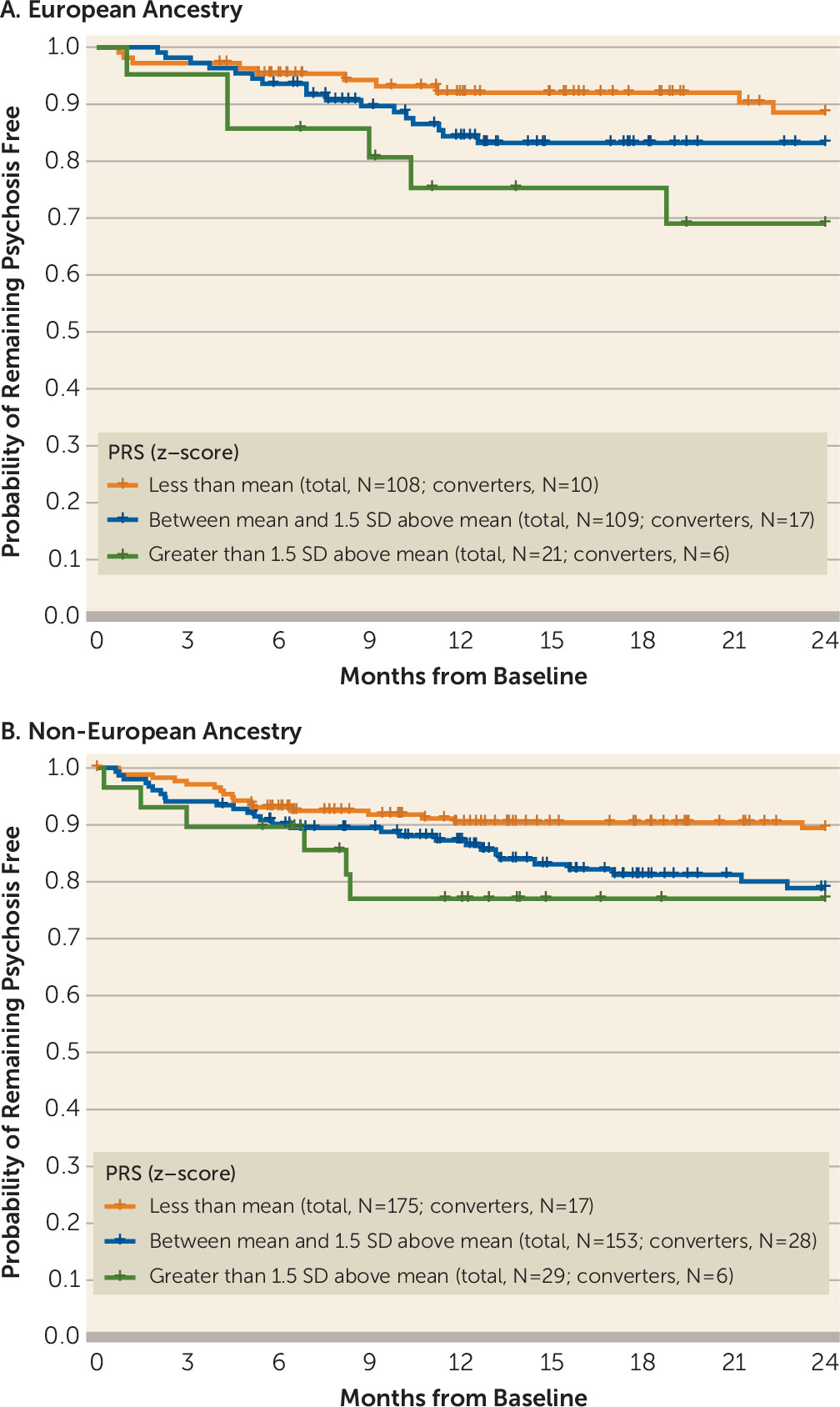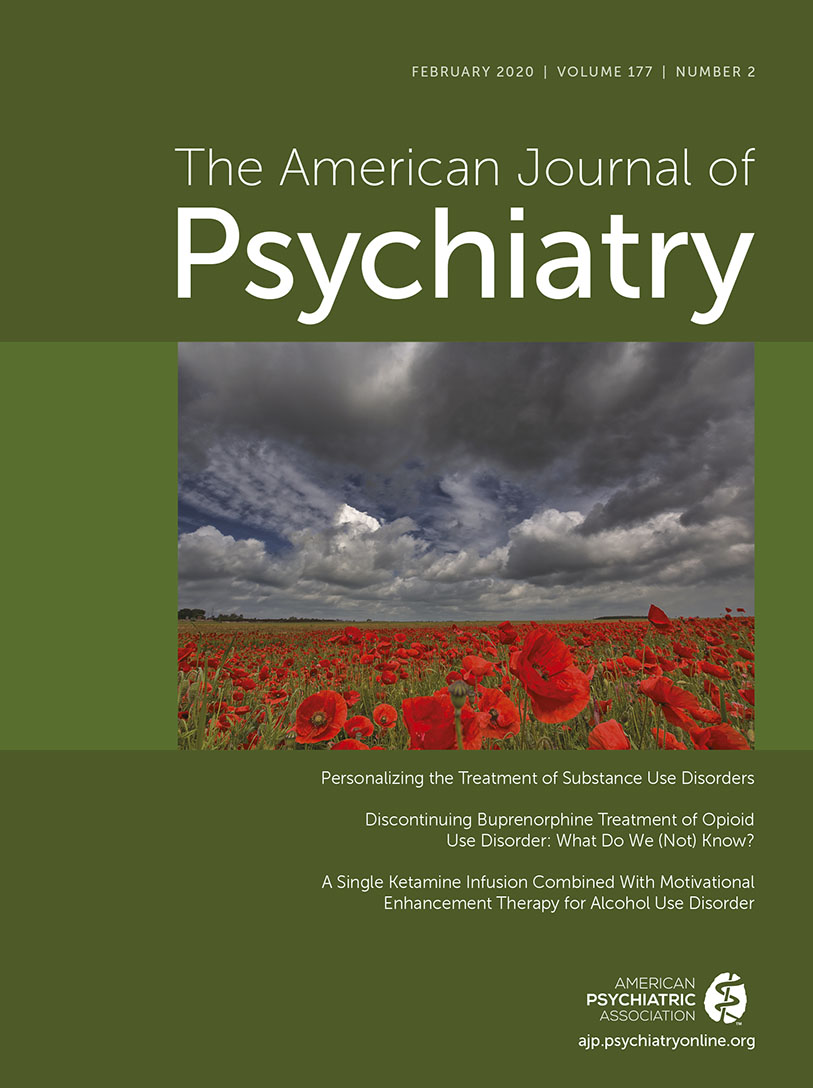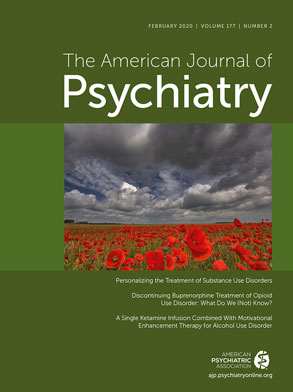Polygenic Risk Score Contribution to Psychosis Prediction in a Target Population of Persons at Clinical High Risk
Abstract
Objective:
Methods:
Results:
Conclusions:
Methods
| Clinical High Risk, Psychosis Converter | Clinical High Risk, Nonconverter | Unaffected Comparison Subjects | ||||||||||
|---|---|---|---|---|---|---|---|---|---|---|---|---|
| Characteristic | Excludedb (N=14) | Included (N=80) | Excludedc (N=422) | Included (N=248) | Excludedd (N=63) | Included (N=216) | ||||||
| Mean | SD | Mean | SD | Mean | SD | Mean | SD | Mean | SD | Mean | SD | |
| Age (years) | 16.90 | 4.01 | 18.27 | 3.50 | 18.24 | 4.15 | 19.09 | 4.53 | 19.21 | 4.48 | 19.91 | 4.71 |
| Maternal educatione | 6.23 | 1.42 | 6.54 | 1.73 | 6.29 | 1.66 | 6.35 | 1.54 | 6.97 | 1.47 | 6.79 | 1.49 |
| Paternal educatione | 5.62 | 1.89 | 6.42 | 1.78 | 6.20 | 1.77 | 6.28 | 1.66 | 6.61 | 1.56 | 6.51 | 1.68 |
| N | % | N | % | N | % | N | % | N | % | N | % | |
| Male | 9 | 64.3 | 50 | 62.5 | 238 | 56.5 | 138 | 55.6 | 32 | 50.8 | 109 | 50.5 |
| Family history of psychosis | 2 | 14.3 | 16 | 20.3 | 54 | 12.9 | 45 | 18.1 | ||||
| Psychiatric diagnoses | ||||||||||||
| Schizophrenia spectrum disordersf | 7 | 50.0 | 34 | 40.0 | ||||||||
| Psychosis not otherwise specified | 6 | 42.9 | 28 | 35.0 | ||||||||
| Major depression with psychosis | 0 | 0.0 | 1 | 1.3 | ||||||||
| Bipolar disorder with psychosis | 0 | 0.0 | 6 | 7.5 | ||||||||
| Unknown | 1 | 7.1 | 11 | 13.7 | ||||||||
| Self-reported ancestry | ||||||||||||
| European | 6 | 42.9 | 47 | 58.8 | 252 | 60.0 | 136 | 54.8 | 31 | 49.2 | 121 | 56.0 |
| African (e.g., African, African Caribbean) | 1 | 7.1 | 11 | 13.8 | 53 | 12.6 | 53 | 21.4 | 6 | 9.5 | 42 | 19.4 |
| Interracial | 4 | 28.6 | 10 | 12.5 | 50 | 11.9 | 33 | 13.3 | 12 | 19.0 | 17 | 7.9 |
| Central or South American | 2 | 14.3 | 2 | 2.5 | 22 | 5.2 | 8 | 3.2 | 5 | 7.9 | 8 | 3.7 |
| South Asian (e.g., East Indian, Pakistani, Sri Lankan) | 1 | 7.1 | 3 | 3.8 | 8 | 1.9 | 6 | 2.4 | 1 | 1.6 | 7 | 3.2 |
| East Asian (e.g., Chinese, Japanese, Korean) | 0 | 0.0 | 4 | 5.0 | 22 | 5.2 | 7 | 2.8 | 5 | 7.9 | 17 | 7.9 |
| First Nations (e.g., North American Indian, Métis, Inuit) | 0 | 0.0 | 1 | 1.2 | 7 | 1.7 | 3 | 1.2 | 1 | 1.6 | 3 | 1.4 |
| Native Hawaiian/Pacific Islander | 0 | 0.0 | 1 | 1.2 | 1 | 0.2 | 1 | 0.4 | 1 | 1.6 | 0 | 0.0 |
| West/Central Asian and Middle Eastern (e.g., Egyptian, Lebanese, Emirati [United Arab Emirates], Afghan, Iranian) | 0 | 0.0 | 1 | 1.2 | 5 | 1.2 | 1 | 0.4 | 1 | 1.6 | 1 | 0.5 |
| Missing | 0 | 0.0 | 0 | 0.0 | 1 | 0.0 | 0 | 0.0 | 0 | 0.0 | 0 | 0.0 |
DNA Analysis
Data Analysis
Calculation of the PRS.
Analysis 1: impact of PRS on psychosis risk prediction in persons at clinical high risk.
Analysis 2: impact of adding PRS to clinical risk prediction models.
Results
Psychosis Conversion in Persons at Clinical High Risk

| Group and Ancestry | Clinical High-Risk Subjects (N) | Unaffected Comparison Subjects (N) | Odds Ratio | 95% CI | Wald Z | p | AUC | R2 for 2-Year Population Psychosis Risk | R2 for 2-Year Population Psychosis Risk | R2 for 2-Year Population Psychosis Risk |
|---|---|---|---|---|---|---|---|---|---|---|
| Clinical high risk with psychosis conversion versus clinical high risk with no psychosis conversion | ||||||||||
| Risk, 10% | Risk, 20% | Risk, 30% | ||||||||
| European | 32 | 92 | 8.21 | 1.57, 43.1 | 2.44 | 0.015 | 0.65 | 0.092 | 0.112 | 0.123 |
| Non-European | 48 | 156 | 1.77 | 0.63, 4.94 | 2.00 | 0.046 | 0.59 | 0.035 | 0.043 | 0.048 |
| Clinical high risk with psychosis conversion versus unaffected comparison subjects | ||||||||||
| Risk, 1% | ||||||||||
| European | 32 | 70 | 22.17 | 3.88, 126 | 3.16 | 0.002 | 0.70 | 0.117 | ||
| Non-European | 48 | 146 | 2.38 | 0.83, 6.84 | 2.51 | 0.012 | 0.62 | 0.032 | ||
| Clinical high risk with no psychosis conversion versus unaffected comparison subjects | ||||||||||
| Risk, 5% | ||||||||||
| European | 92 | 70 | 1.83 | 0.67, 5.05 | 1.33 | 0.184 | 0.53 | 0.007 | ||
| Non-European | 156 | 146 | 1.44 | 0.70, 2.95 | 1.02 | 0.309 | 0.51 | <0.001 | ||
PRS in High-Risk Converters Compared With Unaffected Comparison Subjects
PRS in Clinical High-Risk Nonconverters Compared With Unaffected Comparison Subjects
Impact of Including PRS in the Psychosis Risk Calculator

Discussion
Acknowledgments
Footnote
Supplementary Material
- View/Download
- 364.67 KB
References
Information & Authors
Information
Published In
History
Keywords
Authors
Funding Information
Metrics & Citations
Metrics
Citations
Export Citations
If you have the appropriate software installed, you can download article citation data to the citation manager of your choice. Simply select your manager software from the list below and click Download.
For more information or tips please see 'Downloading to a citation manager' in the Help menu.
View Options
View options
PDF/EPUB
View PDF/EPUBLogin options
Already a subscriber? Access your subscription through your login credentials or your institution for full access to this article.
Personal login Institutional Login Open Athens loginNot a subscriber?
PsychiatryOnline subscription options offer access to the DSM-5-TR® library, books, journals, CME, and patient resources. This all-in-one virtual library provides psychiatrists and mental health professionals with key resources for diagnosis, treatment, research, and professional development.
Need more help? PsychiatryOnline Customer Service may be reached by emailing [email protected] or by calling 800-368-5777 (in the U.S.) or 703-907-7322 (outside the U.S.).

